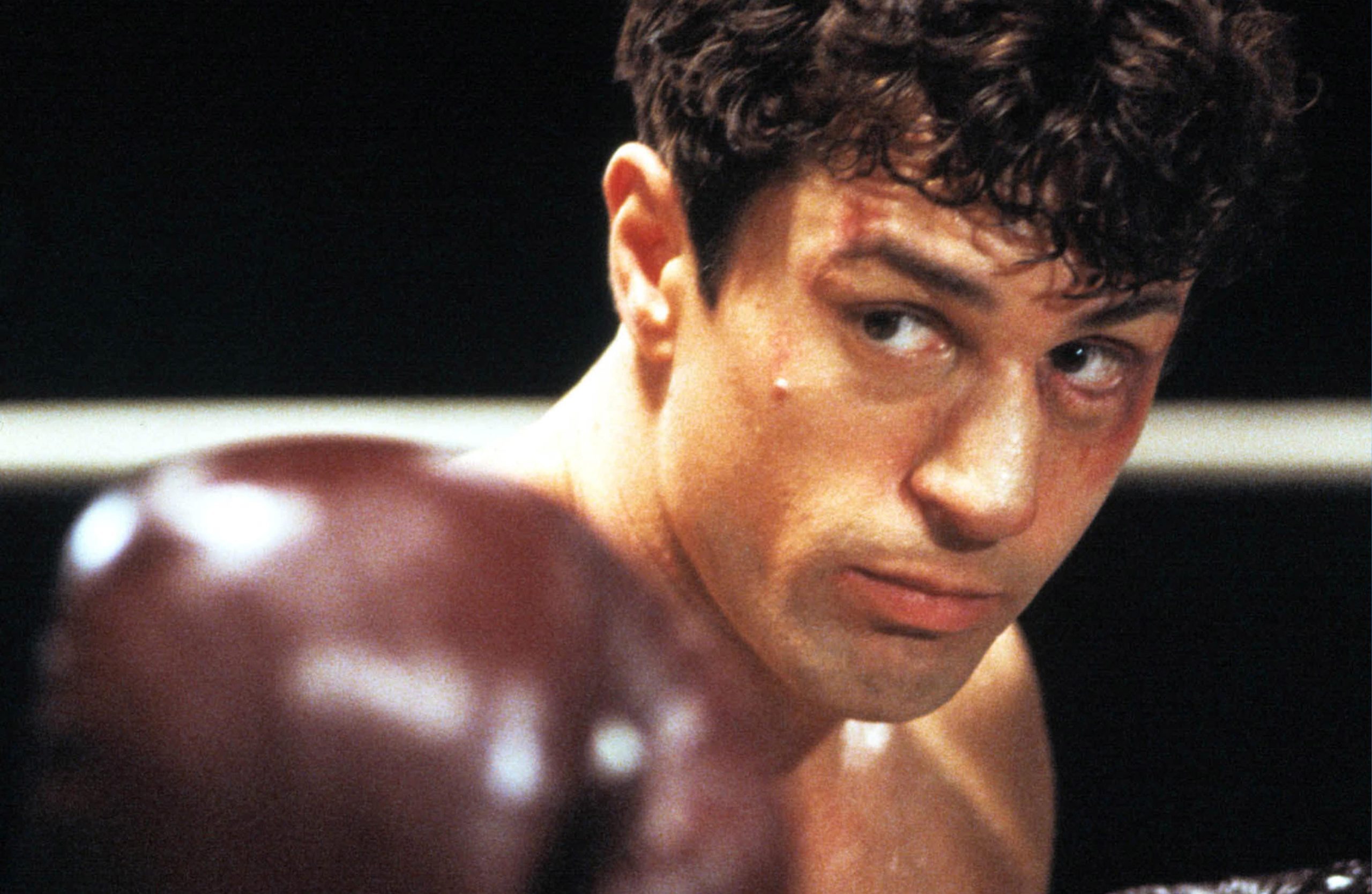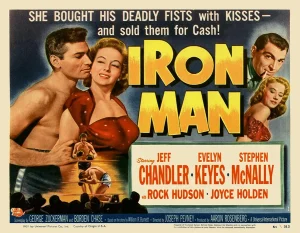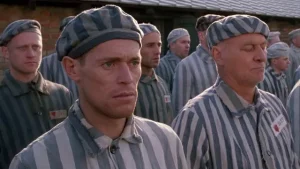
What Is Raging Bull (1980) About?
“Raging Bull” (1980) directed by Martin Scorsese, is a raw and unflinching portrayal of the tumultuous life of boxer Jake LaMotta. Set in the gritty backdrop of the 1940s and 1950s, the film traces LaMotta’s journey from a rising middleweight boxer to his descent into personal turmoil. LaMotta’s relentless pursuit of success in the ring is matched only by his self-destructive tendencies outside of it, as he grapples with jealousy, violence, and inner demons that threaten to consume him. His volatile relationships, particularly with his wife Vickie, serve as a backdrop to his tumultuous career, reflecting the intensity and brutality both in and out of the boxing arena.
Through stunning black-and-white cinematography and powerhouse performances, notably by Robert De Niro as LaMotta, “Raging Bull” captures the visceral essence of a man driven by his demons. LaMotta’s journey serves as a poignant exploration of masculinity, violence, and redemption, as he navigates the unforgiving world of boxing while battling his own inner turmoil. Scorsese’s masterful direction combined with De Niro’s immersive portrayal elevates “Raging Bull” beyond a mere sports drama, making it a timeless cinematic masterpiece that delves deep into the complexities of human nature and the destructive allure of self-destruction.
For more boxing-related movies, including ‘Creed 3,’ click here.
What Is the Plot of the Movie?
“Raging Bull” intricately chronicles the life of Jake LaMotta, a volatile and relentless boxer whose personal demons overshadow his professional success. The film delves into LaMotta’s early days as a promising fighter in the 1940s, showcasing his determination to climb the ranks of the boxing world. However, LaMotta’s temper and paranoia strain his relationships, particularly with his wife Vickie, whom he suspects of infidelity.
As LaMotta’s boxing career flourishes, his self-destructive tendencies escalate, leading to a series of violent outbursts both in and out of the ring. Despite his achievements in the boxing arena, LaMotta’s inner turmoil and destructive behavior threaten to derail his career and personal life. His struggles with jealousy, insecurity, and rage culminate in his isolation from his family and a downward spiral into obscurity.
Through stunning cinematography and powerful performances, notably by Robert De Niro in the role of LaMotta, “Raging Bull” immerses viewers in the tumultuous world of professional boxing and the turbulent psyche of its protagonist. The film’s unflinching portrayal of LaMotta’s triumphs, tragedies, and personal demons makes it a haunting and unforgettable cinematic experience, exploring themes of masculinity, violence, and redemption amidst the brutality of the sport.
Reasons to Watch It
“Raging Bull” offers a cinematic tour de force with Robert De Niro’s unforgettable portrayal of Jake LaMotta, backed by Martin Scorsese’s directorial brilliance. Through its iconic performances, stunning cinematography, and profound character study, the film stands as a timeless masterpiece, leaving a lasting legacy in the history of cinema.
- Iconic Performances:
- Robert De Niro’s portrayal of Jake LaMotta is widely regarded as one of the greatest performances in the history of cinema. Watching De Niro’s transformative and intense performance is a cinematic experience in itself.
- Directorial Excellence:
- Martin Scorsese, one of the most acclaimed directors in the industry, helmed “Raging Bull.” The film showcases Scorsese’s skill in storytelling, character development, and creating visually striking and emotionally resonant scenes.
- Cinematography:
- The black-and-white cinematography by Michael Chapman is exceptional, capturing the raw intensity of the story. The visual style of the film is often praised for its beauty and stark realism.
- Character Study:
- “Raging Bull” is not just a boxing movie; it’s a deep character study of a complex and flawed individual. The film delves into the psychology of Jake LaMotta, exploring themes of self-destructiveness, jealousy, and redemption.
- Realism and Grit:
- The film’s portrayal of the boxing world is known for its realism and grit. The fight scenes are intense and visceral, providing an authentic look at the brutality of the sport and its impact on the characters.
- Impact on Cinema:
- “Raging Bull” has had a profound influence on the filmmaking industry and is often cited as a landmark film. Watching it can provide insight into the evolution of cinematic techniques and storytelling.
- Acclaimed Storytelling:
- The narrative, based on Jake LaMotta’s memoir, is compelling and emotionally charged. The film explores universal themes of human struggle, redemption, and the consequences of one’s actions.
- Cinematic Legacy:
- “Raging Bull” is frequently included in discussions about the greatest films ever made. Watching it allows viewers to engage with a piece of cinema history and appreciate its lasting impact on the art form.
While individual tastes vary, “Raging Bull” is celebrated not only for its technical and artistic achievements but also for its profound exploration of the human condition. If you appreciate powerful performances, exceptional filmmaking, and thought-provoking storytelling, “Raging Bull” is a film that’s often recommended.
For more boxing-related movies, including ‘Southpaw,’ click here.
Is the Movie a Real or Fictional Story?
“Raging Bull” is a biographical film based on the real-life experiences of former middleweight boxer Jake LaMotta. The movie is an adaptation of LaMotta’s memoir, titled “Raging Bull: My Story,” which was co-written by Joseph Carter and Peter Savage.
While the film is rooted in the actual events of Jake LaMotta’s life, it’s important to note that cinematic adaptations often take creative liberties for dramatic purposes. The portrayal of events, characters, and certain aspects of LaMotta’s life may be dramatized or altered for storytelling impact.
In essence, “Raging Bull” is a blend of both real and fictional elements, with the core narrative drawing heavily from the boxer’s own recollections and experiences. The film provides a character study that explores the complexities of LaMotta’s personality, his relationships, and the challenges he faced both inside and outside the boxing ring.
| Aspect | Description |
|---|---|
| Biographical Basis | “Raging Bull” is a biographical film based on the real-life experiences of former middleweight boxer Jake LaMotta. It serves as an adaptation of LaMotta’s memoir, “Raging Bull: My Story.” |
| Creative Liberties | While rooted in actual events, the film takes creative liberties for dramatic purposes. Certain events, characters, and aspects of LaMotta’s life may be dramatized or altered for storytelling impact. |
| Real vs. Fictional Elements | The movie is a blend of both real and fictional elements, drawing heavily from LaMotta’s own recollections and experiences while also incorporating dramatized elements for narrative effect. |
| Character Study | “Raging Bull” provides a deep character study that explores the complexities of LaMotta’s personality, relationships, and the challenges he faced in both his personal life and boxing career. |
For more boxing-related movies, including ‘Bleed for This,’ click here.
Is It Critically Panned or Acclaimed?
“Raging Bull” is widely acclaimed by critics and is considered one of the greatest films in the history of cinema. The movie received significant praise for various aspects, including the performances, direction, cinematography, and storytelling. Here are some key points regarding the critical reception of “Raging Bull”:
- Academy Awards:
- The film was nominated for eight Academy Awards and won two. Robert De Niro received the Oscar for Best Actor for his portrayal of Jake LaMotta, and Thelma Schoonmaker won the award for Best Editing.
- Critical Reviews:
- Critics lauded the film for its intense and realistic portrayal of the boxing world, the exceptional performances, Martin Scorsese’s direction, and the striking black-and-white cinematography by Michael Chapman.
- Cultural Impact:
- Over the years, “Raging Bull” has had a lasting impact on cinema and is often cited in discussions about the best films ever made. It has been included in numerous lists of the greatest movies of all time.
- Legacy:
- The film’s influence extends beyond its initial release, and it is studied in film schools for its technical achievements and storytelling prowess.
| Aspect | Description |
|---|---|
| Academy Awards | “Raging Bull” was nominated for eight Academy Awards and won two. Robert De Niro received the Oscar for Best Actor for his portrayal of Jake LaMotta, while Thelma Schoonmaker won for Best Editing. |
| Critical Reviews | Critics praised the film for its intense and realistic portrayal of the boxing world, exceptional performances, Martin Scorsese’s direction, and the striking black-and-white cinematography by Michael Chapman. |
| Cultural Impact | Over the years, “Raging Bull” has had a profound impact on cinema and is frequently cited in discussions about the greatest films ever made. It has been included in numerous lists of the greatest movies of all time. |
| Legacy | The film’s influence extends far beyond its initial release, and it is often studied in film schools for its technical achievements and storytelling prowess. |
| Audience Considerations | While acclaimed, “Raging Bull” may not be suitable for all audiences due to its intense portrayal of violence and complex characters. However, its critical acclaim highlights its significance in the world of cinema. |
While “Raging Bull” received critical acclaim, it’s important to note that the film’s intense and often raw depiction of its characters and subject matter might not appeal to all audiences. Some viewers may find the film challenging due to its portrayal of violence and the complex nature of its protagonist. Nonetheless, its critical acclaim underscores its significance in the world of cinema.
For more boxing-related movies, including ‘The Hurricane,’ click here.
What Does the Movie Explore?
“Raging Bull” explores several themes and facets of the human condition, offering a profound and intense portrayal of its central character, Jake LaMotta. Here are some key themes and elements explored in the film:
- Self-Destructiveness:
- The film delves into the self-destructive tendencies of Jake LaMotta, both inside and outside the boxing ring. His behavior, fueled by jealousy, paranoia, and a volatile temperament, becomes a central aspect of the narrative.
- Jealousy and Paranoia:
- Jake LaMotta’s personal relationships, especially his marriage to his second wife Vickie, are marked by intense jealousy and paranoia. The film explores the destructive impact of these emotions on his family life.
- Redemption and Regret:
- As LaMotta’s life takes a tumultuous turn, the film examines his journey toward redemption and the consequences of his past actions. The narrative explores whether true redemption is possible for a character with such a turbulent and violent history.
- Boxing as Catharsis:
- The sport of boxing serves as both a profession and a form of catharsis for Jake LaMotta. The film explores how the physicality of boxing allows him to channel his inner turmoil and emotions into the ring.
- Family and Relationships:
- “Raging Bull” delves into the complexities of family dynamics, particularly the strained relationships between LaMotta and his wives and brother. The impact of his actions on those closest to him is a significant aspect of the narrative.
- Physical and Emotional Toll of Boxing:
- The film provides a visceral portrayal of the physical toll that boxing takes on the body, as well as the emotional toll it exacts on the psyche of a fighter. LaMotta’s career is depicted as both a source of triumph and a pathway to personal destruction.
- Isolation and Alienation:
- Despite his success in the boxing world, LaMotta is depicted as a lonely and isolated figure. The film explores the alienation he experiences, both as a result of his own actions and the nature of his profession.
- Cinematic Style and Symbolism:
- Martin Scorsese’s direction and the film’s cinematography contribute to the exploration of themes. The use of black-and-white visuals, slow-motion sequences, and intense close-ups enhances the emotional and psychological impact of the narrative.
“Raging Bull” is not just a sports biopic; it’s a character study that delves into the complexities of human nature, the consequences of destructive behavior, and the potential for redemption. The film’s exploration of these themes, coupled with its technical brilliance, has contributed to its lasting impact in the world of cinema.
For more boxing-related movies, including ‘Million Dollar Baby’ click here.
Memorable Moments in the Movie
The opening credits of “Raging Bull” set a powerful tone with a slow-motion sequence of Jake LaMotta preparing for a boxing match, while memorable scenes like Jake’s defiant declaration after a brutal beating and his introspective prison monologue showcase the film’s depth and intensity. Martin Scorsese’s use of slow-motion during the fight sequences adds visual impact, and the closing moments provide a poignant conclusion to Jake LaMotta’s tumultuous journey.
- Opening Credits:
- The film begins with a powerful slow-motion sequence of Jake LaMotta preparing for a boxing match. This sets the tone for the visual style and intensity of the film.
- “You Never Got Me Down”:
- After a brutal beating in the ring, Jake stands bloodied but defiant, uttering the famous line “You never got me down, Ray!” This moment captures LaMotta’s resilience and determination.
- The “Sugar” Ray Robinson Bouts:
- The various boxing matches between Jake LaMotta and Sugar Ray Robinson are intense and crucial to the film. The choreography and cinematography during these scenes are particularly noteworthy.
- LaMotta’s Confession:
- In a poignant scene, Jake confesses to his brother Joey about his fear and inadequacy, shedding light on his inner struggles beyond the tough exterior he presents to the world.
- Prison Monologue:
- The scene where Jake reflects on his life in prison is a powerful monologue delivered by Robert De Niro. It provides insight into the character’s regrets and the consequences of his actions.
- “I’m Not in the Circus”:
- The confrontation between Jake and his brother Joey, where Jake defiantly declares, “I’m not in the circus,” is a pivotal moment in their strained relationship.
- Domestic Disturbance:
- The intense domestic scenes, especially those involving Jake’s second wife, Vickie, showcase the volatile nature of his relationships and the destructive impact of jealousy.
- Mirror Scene:
- The scene where Jake, alone in his dressing room, practices a monologue in front of a mirror is a haunting moment that reflects his internal turmoil and self-awareness.
- Slow-Motion Fight Sequences:
- Throughout the film, Scorsese uses slow-motion to capture the brutality and poetry of the boxing matches, turning them into visually striking and emotionally charged sequences.
- Final Moments:
- The film’s closing scenes, including Jake’s reflection on his life in a nightclub and his confrontation with his younger self in the ring, provide a poignant conclusion to the narrative.
These moments, coupled with Robert De Niro’s transformative performance and Martin Scorsese’s direction, contribute to the enduring impact and acclaim of “Raging Bull.”
For more boxing-related movies, including ‘Gladiator,’ click here.
Streaming Platforms to Watch the Movie From
“Raging Bull” may be available for rent or purchase on various digital platforms such as Amazon Prime Video, iTunes/Apple TV, Google Play Movies & TV, Vudu, and YouTube Movies, providing viewers with convenient access to the acclaimed film. Additionally, depending on regional availability, subscribers to streaming services like Hulu and HBO Max may also have access to “Raging Bull” as part of their subscription packages.
- Amazon Prime Video:
- Amazon Prime Video is a popular streaming service that offers a wide range of movies and TV shows. “Raging Bull” may be available for rent or purchase on this platform.
- iTunes/Apple TV:
- iTunes and Apple TV provide a digital storefront where you can rent or purchase movies, including “Raging Bull.” You can stream the film directly through the Apple ecosystem.
- Google Play Movies & TV:
- Google Play Movies & TV is a digital distribution platform where you can rent or buy movies. “Raging Bull” may be available for streaming on this platform.
- Vudu:
- Vudu is a digital streaming service where you can rent or purchase movies. “Raging Bull” may be offered for rent or purchase on Vudu’s platform.
- YouTube Movies:
- YouTube Movies is a platform where you can rent or buy digital copies of movies. “Raging Bull” might be available for rental or purchase on YouTube.
- Hulu:
- Hulu is a subscription-based streaming service that offers a variety of movies and TV shows. Depending on your region, “Raging Bull” may be included in the Hulu library.
- Netflix:
- Netflix is a popular subscription-based streaming service known for its extensive library of movies and TV series. However, as of my last update, “Raging Bull” may not be available on Netflix in all regions.
- HBO Max:
- HBO Max is a streaming service that includes content from HBO, as well as a variety of additional movies and shows. “Raging Bull” might be available on HBO Max, but availability can vary by region.
To watch “Raging Bull,” it’s advisable to verify the current availability on these platforms in your region, as streaming rights and offerings can vary and change over time. Checking each platform individually ensures that you have the most up-to-date information on where to find the film, whether it’s available for rent, purchase, or included in a subscription service. Additionally, keep in mind that regional differences may affect the availability of “Raging Bull” on certain platforms, so exploring multiple options ensures you can access the film through the platform that best suits your preferences and subscription status.
For more boxing-related movies, including ‘The Fighter,’ click here.






